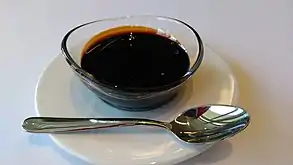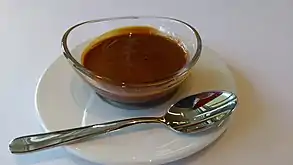Corn sauce or fermented corn sauce is produced by fermentation using corn starch as the primary substrate. It is used as a food condiment and ingredient, both in paste and in powder form. Corn sauce, like soy sauce, has a characteristic savory taste. It is used to flavor dishes including soups, broths, and gravies.


Taste and usage
Corn sauce is a mix of free and bound amino acids, organic acids and their salts, Maillard reaction products, and minerals. Sensory analysis describes corn sauce with characteristic savory tastes including 'xian' (鲜 in Chinese), umami, caramelized, roasted, slightly yeasty, meaty, salty, and sweet.[1]
The taste of corn sauces has been subject to research, showing that the complexity of the taste results from the composition of salts and fermentation metabolites, amino acids, acetic acid, ribotides, short peptides and carbohydrates.[2] Additionally, glutamyl-dipeptides were identified as a class of enriching taste compounds.[3]

The taste of corn sauce led to the usage as a condiment. Like yeast extract, soy sauce and hydrolyzed vegetable protein, it rounds off the flavor and taste.[4]
Manufacturing process
Comparable to the production of soy sauce, corn sauce is obtained by fermentation, sometimes referred as brewing. The fermentation process is using Corynebacterium bacteria species.[5] The fermentation parameters are controlled for time, temperature and pH. After fermentation the broth undergoes a cooking step to kill the fermenting microorganisms and to induce a controlled Maillard reaction. The cell mass is removed by filtration. The filtered broth is concentrated in order to obtain a paste and to create further Maillard products. During evaporation, salt is added to improve microbial stability. For a powdered product a drying step is applied.

Composition
Corn sauce contains a mix of compounds, including fermentation metabolites, amino acids, organic acids, minerals and salts. Flavor and color compounds are generated by Maillard reaction during the fermentation, cooking and drying process. Glutamic acid, alanine, and proline are the most abundant present amino acids. Other metabolites are ribotides, sugars, organic acids and γ-glutamyl-dipeptides, which are known to have taste-modulating properties.[2]
Labeling
On labels listed as “Corn sauce” or "Fermented corn sauce" listing the used ingredients (corn starch, water, salt).
Food safety
The fermentation of food with Corynebacterium species is widely present in many parts of the world.[6] The global exposure to these microorganisms in food fermentations assures its safe use and acceptance for food production globally.[7][8] The question of toxicity of corn sauce was negated by toxicological studies.[9]
See also
References
- ↑ Ulmer, H; Charve, J; Manganiello, S; Glabasnia, A (2018). "Decoding the savory taste of a fermented corn-sauce using a sensory-guided fractionation approach". Proceedings of the Sixth Annual International Symposium on Umami Science and Quality of Life. – via Sixth annual international symposium on umami science and quality of life. Shanghai, P.R. China.
- 1 2 Charve, J; Manganiello, S; Glabasnia, A (2018). "Analysis of Umami Taste Compounds in a Fermented Corn Sauce by Means of Sensory-Guided Fractionation". Journal of Agricultural and Food Chemistry. 66 (8): 1863–1871. doi:10.1021/acs.jafc.7b05633. ISSN 0021-8561. PMID 29397710.
- ↑ Dunkel, A; Köster, J; Hofmann, T (2007). "Molecular and Sensory Characterization of γ-Glutamyl Peptides as Key Contributors to the Kokumi Taste of Edible Beans (Phaseolus vulgarisL.)". Journal of Agricultural and Food Chemistry. 55 (16): 6712–6719. doi:10.1021/jf071276u. ISSN 0021-8561. PMID 17616213.
- ↑ Yoshida, Yoshiko (1998). "Umami taste and traditional seasonings". Food Reviews International. 14 (2–3): 213–246. doi:10.1080/87559129809541158. ISSN 8755-9129.
- ↑ F., Stanbury, Peter (1984). Principles of fermentation technology. Pergamon Press. p. 99. ISBN 9781483292915. OCLC 563540490.
{{cite book}}: CS1 maint: multiple names: authors list (link) - ↑ F., Haard, Norman (1999). Fermented cereals a global perspective. Food and Agriculture Organization of the United Nations. ISBN 978-9251042960. OCLC 803037972.
{{cite book}}: CS1 maint: multiple names: authors list (link) - ↑ Shin, N.-R.; Jung, M.-J.; Kim, M.-S.; Roh, S. W.; Nam, Y.-D.; Bae, J.-W. (2010-11-12). "Corynebacterium nuruki sp. nov., isolated from an alcohol fermentation starter". International Journal of Systematic and Evolutionary Microbiology. 61 (10): 2430–2434. doi:10.1099/ijs.0.027763-0. ISSN 1466-5026. PMID 21075904.
- ↑ "Bulletin of the IDF 455/ 2012: Safety Demonstration of Microbial Food Cultures (MFC) in Fermented Food Products, The 2012 inventory of the microbial species with technological beneficial role in fermented food products". 2012. pp. 22–61.
- ↑ Tafazoli, S; Vo, TD; Petersen, A; Constable, A; Coulet, M; Phothirath, P; Lang, J; Baldwin, N (2017). "Genotoxicity, acute and subchronic toxicity evaluation of savory food ingredients". Regulatory Toxicology and Pharmacology. 87: 71–87. doi:10.1016/j.yrtph.2017.05.006. ISSN 0273-2300. PMID 28487066.